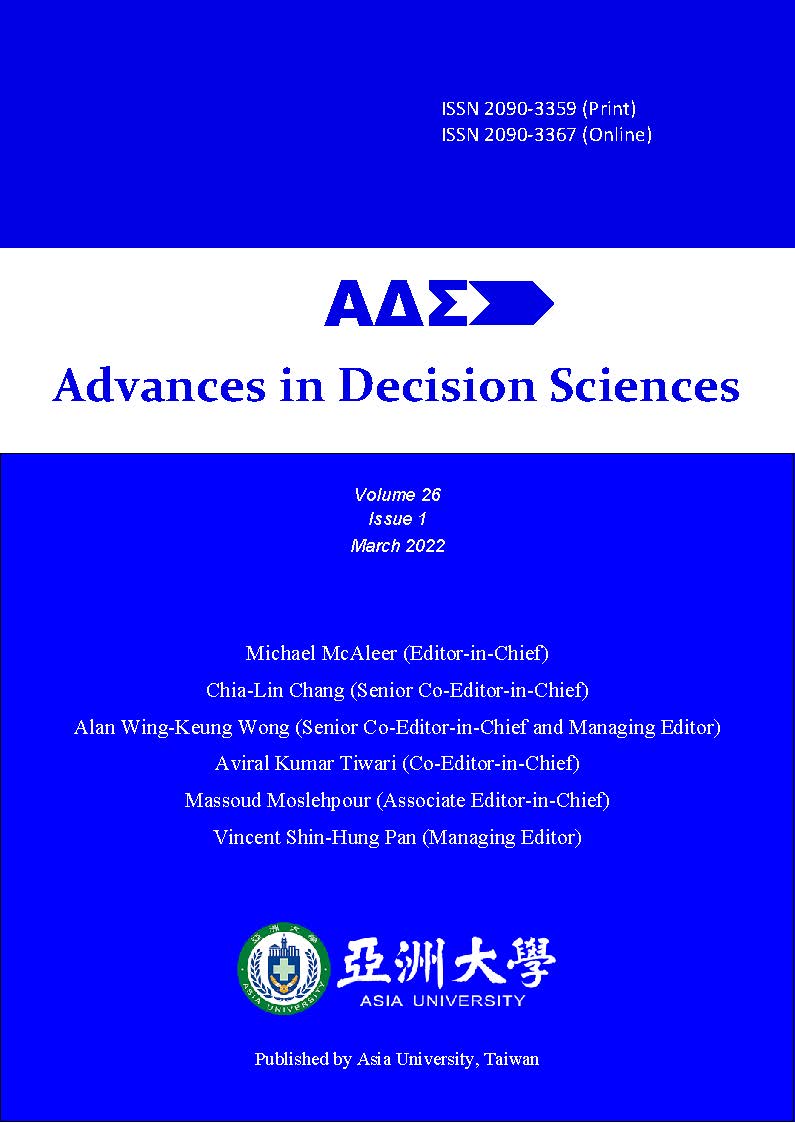Extension of Classical TOPSIS Method Using Q-Rung Orthopair Triangular Fuzzy Number
DOI:
https://doi.org/10.47654/v26y2022i1p163-187Keywords:
Q-Rung orthopair fuzzy sets, TOPSIS, supplier selection, multiple attribute group decision-makingAbstract
Purpose- As an extension of pythagorean fuzzy sets, the q‐rung orthopair fuzzy sets (q‐ROFSs) can effectively deal with unclear information in Multi Attribute Decision Making (MADM) problems. This manuscript proposes a comprehensive model to cope with supplier selection multi-attribute group decision-making (MAGDM) problem.
Design/methodology/approach- The paper presents a new method for supplier selection multi-attribute group decision making (MAGDM) problems in uncertain situations. The technique utilizes experts' knowledge represented by q-rung orthopair fuzzy sets. It considers the suitability of a supplier (i.e., flexibility, quality, price, supplier profile, delivery) using constructed new fuzzy TOPSIS approach. With the advantages of the calculation model not needing aggregation operators and the superiority of q-ROFNs, this manuscript attempts to extend the traditional TOPSIS method using q-rung orthopair triangular fuzzy sets. The extended classical TOPSIS method using q-rung orthopair triangular fuzzy number (q-ROTFN) is constructed in 13 steps.
Findings- To verify the proposed technique, this study used it for assessing and ranking suppliers in the automotive industry. The results exhibited the success and superiority of the proposed method.
Originality/value-The main contributions of this paper are as follows: (i) To solve multi-attribute decision problems, this study extends the traditional TOPSIS method to the q-rung orthopair fuzzy, (ii) This manuscript presents q-rung orthopair triangular fuzzy TOPSIS method not needing aggregation techniques, (iii) This paper proposes a novel expert weight calculation technique. (iv) The proposed model is applied for assessing and ranking suppliers in the automotive industry.
References
Atanassov, K. T. (1986). Intuitionistic fuzzy sets. Fuzzy Sets System, 20 (1), 87–96.
Ayyildiz, E. (2021). Interval-valued intuitionistic fuzzy analytic hierarchy process-based green supply chain resilience evaluation methodology in post-COVID-19 era. Environmental Science and Pollution Research, 1-19.
Ayyildiz, E., & Gumus, A. T. (2021). Pythagorean fuzzy AHP based risk assessment methodology for hazardous material transportation: an application in Istanbul. Environmental Science and Pollution Research, 1-13.
Chen (2000). Extensions of the TOPSIS for group decision-making under fuzzy environment. Fuzzy Sets and Systems.
Hung, C.C., & Chen, L.H. (2009). A Fuzzy TOPSIS Decision Making Model with Entropy Weight under Intuitionistic Fuzzy Environment. International Multiconference of Engineers & Computer Scientists, 13–16.
Hussain A., Irfan A. M., & Mahmood T. (2019). Covering based q-rung orthopair fuzzy rough set model hybrid with TOPSIS for multi-attribute decision making. Journal of Intelligent & Fuzzy Systems, 1-13.
Hwang C. L. & Yoon, K. (1981). Methods for multiple attribute decision making, in Multiple Attribute Decision Making. Berlin, Germany: Springer-Verlag.
Jahanshahloo, G. R., Hosseinzadeh, L.F., & Izadikhah, M. (2006). Extension of the TOPSIS method for decision-making problems with fuzzy data. Applied Mathematics and Computation, 181, 1544–1551.
Joshi, B. P., Singh, A., & P.K. Bhatt (2018). Interval valued q-rung orthopair fuzzy sets and their properties. Journal of Intelligent & Fuzzy Systems, 35 (5), 5225-5230.
Krishankumar, R., Nimmagadda, S.S., Rani, Mishra, P., A. R., Ravichandran, K.S., & Gandomi, A. H. (2021). Solving renewable energy source selection problems using a q-rung orthopair fuzzy-based integrated decision-making approach. Journal of Cleaner Production, 279.
Liang, D., & Cao, W. (2019). Q-Rung orthopair fuzzy sets‐based decision‐theoretic rough sets for three‐way decisions under group decision making. International Journal of Intelligent Systems, 34(12), 3139-3167.
Liu P., Liu P., Wang P., & Zhu, B. (2019). An extended multiple attribute group decision making method based on q-Rung orthopair fuzzy numbers. IEEE Access 7, 162050-162061.
Liu, D., Peng D., & Liu, Z. (2019). The distance measures between q‐rung orthopair hesitant fuzzy sets and their application in multiple criteria decisions making. International Journal of Intelligent Systems, 34 (9), 2104-2121.
Liu, P, Chen, S. M., & Wang, P. (2018). Multiple-attribute group decision-making based on q-rung orthopair fuzzy power maclaurin symmetric mean operators. IEEE Transactions on Systems, Man, and Cybernetics: Systems 50 (10), 3741-3756.
Liu, P., & Wang Y. (2020). Multiple attribute decision making based on q-rung orthopair fuzzy generalized Maclaurin symmetric mean operators. Information Sciences, 518, 181-210.
Liu, P., & Wang, P. (2018). Some q-rung orthopair fuzzy aggregation operators and their applications to multiple-attribute decision making. International Journal of Intelligent Systems, 33 (2), 259-280.
Tang, G., Chiclana, F. & Liu, P. (2020). A decision-theoretic rough set model with q-rung orthopair fuzzy information and its application in stock investment evaluation. Applied Soft Computing, 91.
Wang, J., Wei, G., Wei, C., & Wei, Y. (2019). MABAC method for multiple attribute group decision making under q-rung orthopair fuzzy environment. Defence Technology, 16 (1) (2019), 208-216.
Yager, R. R. (2014). Pythagorean membership grades in multi-criteria decision making. IEEE Trans. Fuzzy Syst., 22 (4), 958–965.
Yager, R. R. (2017). Generalized orthopair fuzzy sets. IEEE Trans. Fuzzy Syst., 25(5), 1222–1230.
Yoon K., & Hwang, C. (1980). Multiple attribute decision making: Methods and applications A State-of-the-Art Survey. Lecture Notes in Economics and Mathematical Systems book series (LNE, volume 186). SpringerVerlag.
Youssef, M. A., Zairi, M., & Mohanty, B. (1996). Supplier selection in an advanced manufacturing technology environment: an optimization model. Benchmarking for Quality Management & Technology 3 (4), 60-72.
Zadeh, L. A. (1965). Fuzzy sets. Inf. Control, 8 (3), 338–35.
Yager, R. R., & Alajlan, N. (2017). Approximate reasoning with generalized orthopair fuzzy sets. Information Fusion, 38, 65–73.
Peng, X., & Liu, L. (2019). Information measures for q‐rung orthopair fuzzy sets, International Journal of Intelligent Systems 34, 1795-1834.
Peng, X., Dai, J., & Garg, H. (2018). Exponential operation and aggregation operator for q‐rung orthopair fuzzy set and their decision‐making method with a new score function. International Journal of Intelligent Systems 33 (11), 2255-2282.
Xu, Z. (2007). Intuitionistic fuzzy aggregation operators, IEEE Trans. Fuzzy Syst., 15 (6), 1179–1187.
Yang, Z., Li, X., Cao, Z., & Li, J. (2019). Q-rung orthopair normal fuzzy aggregation operators and their application in multi-attribute decision-making. Mathematics, 7 (12).

Published
Issue
Section
License
Copyright (c) 2021 Advances in Decision Sciences

This work is licensed under a Creative Commons Attribution-NonCommercial 4.0 International License.







 Scientific and Business World
Scientific and Business World